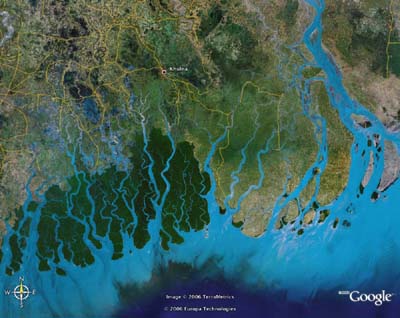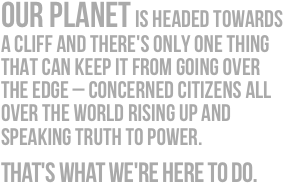A few shots from week one of the conference, and some proof that we did escape for long enough to see some of India.
All posts in Beyond the Negotiations
An effective environmental treaty? Montreal Protocol.
by nathan thanki (march 2011)

When astronauts first looked out the window of their spacecraft onto the only planet they had ever known, what they would have seen is a thin blue layer enveloping the globe. Without this layer, life on earth would probably not exist. The stratospheric ozone layer contains 90% of the world’s known ozone (Chasek et al 164), and is life giving because it absorbs ultraviolet radiation, large amounts of which damage all forms of life. Alarm was raised in the 1970s about the state of this protective layer when scientists such as Mario Molina and F. Sherwood Rowland discovered that chemicals, including chlorofluorocarbons (CFCs) were destroying ozone molecules (Chasek et al 164) (Mossos 1). The discovery that CFCs – as well as halons, carbon tetrachloride, methyl chloride, methyl chloroform, and methyl bromides (collectively grouped as ozone depleting substances [ODS]) – were so damaging to the ozone, made worldwide headlines. Not all the reactions to this new environmental problem were reactions born of concern. CFCs are important to various industries; as “refrigerants, propellants, insulators, and solvents” (Thoms 2), and so industries that provided or used CFCs grouped themselves together in The Alliance for Responsible CFC Policy, in an attempt to prevent or delay CFC regulation (Thoms 2). However, all the governments of the world were forced to act in 1986, after further scientific research revealed that a hole had been forming in the ozone layer over Antarctica: the result of which is the much celebrated Montreal Protocol on Substances that Deplete the Ozone Layer. It is usually hailed as a “giant step forward” (Thoms 3) because the global community identified a problem, and agreed to reduce the causes (in this case CFCs – reduced by 50% below 1986 levels by 2000), making it one of only two multilateral environmental agreements – the other being CITES – that have “functioning and active compliance mechanisms” (Victor 14). It also has a mechanism for FTA that has been the model for many environmental regimes since.
An effective treaty is one that: many (ideally all) actors are party to, has timetables for achieving goals, has a mechanism to ensure compliance, has a financial tool that allows Parties which wish to comply to do so without damaging their economy, and perhaps most importantly and effective treaty is one which is able to evolve alongside the problem is wishes to solve. To understand how effective the ozone regime has been, and how it could be more so, we must take a closer look at the history and details – especially measures for compliance and FTA – of the Montreal Protocol.
USA v China
by nathan thanki
The USA wants to be treated the same as China when it comes to responsibility for tackling climate change. Many environmental NGOs, in the increasingly panicked calls for climate action now, are also prone to saying things like "well of course the emerged economies of Brazil, India and China must also be obliged to reduce emissions." This plays quite well into the rich country strategy of stalling their own ambition (both in terms of reducing their emissions and in terms of financing adaptation and mitigation in developing countries) and worsening the climate crisis, while at the same time setting up an international treaty to lock in China et al to reduce emissions. This ignores the fact that there is already a process for developed countries to reduce–the Kyoto protocol–and for developing countries (plus the USA which is still "developing" in terms of being globally responsible for anything other than blowing stuff up, planning coups and stealing oil) –the track for "long-term cooperative action" or AWG-LCA. This ignores too the hundreds of millions of people living in poverty in these countries for whom emissions reductions are laughable, as they emit next to nothing in the first place. But more than anything, it ignores the past. The graph below illustrates better than I can what that history shows us.
Adaptation in Bangladesh: closer look at NAPA
by nathan thanki (Nov 2010)

Climate change is the defining challenge of our generation, if not our species. The six billion and counting human inhabitants of the earth will soon be coming up against the full force of this change and the question they will ask is not ‘how can we stop it?’ but rather ‘how can we survive it?’ How can societies adapt themselves in order to be able to limit the negative impacts climate change will have on them? Under the United Nations Framework Convention on Climate Change (UNFCCC), ‘less developed’ countries of the world have begun planning for the necessary adaptations. This plan comes in the form of a National Adaptation Programme of Action (NAPA). In this paper I will be focusing on the NAPA of Bangladesh and more specifically on the one project therein which has received funding and has begun to be implemented.


